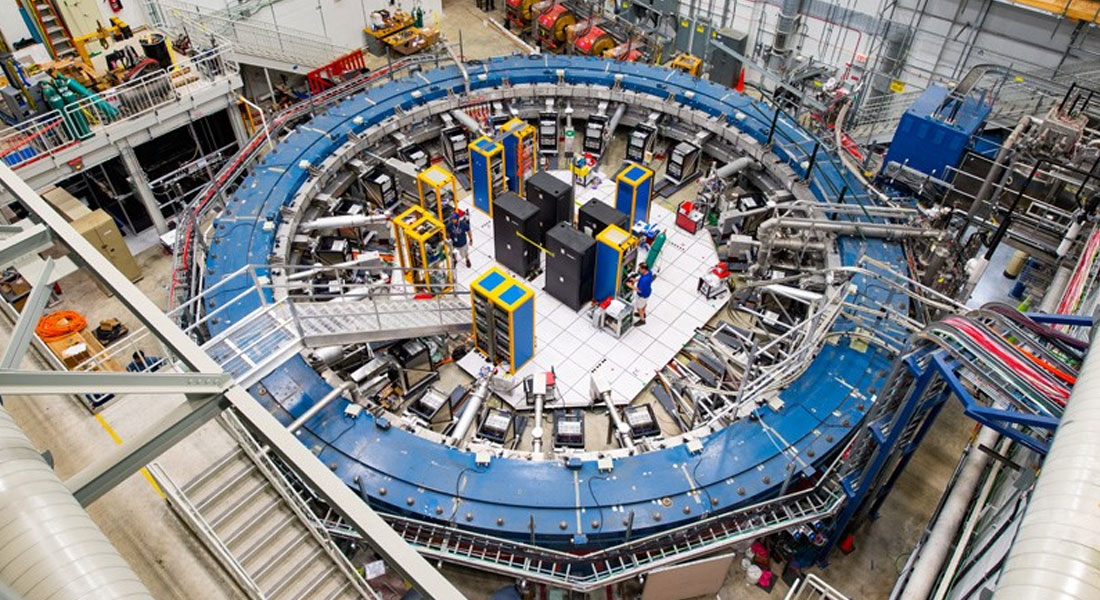New physics at stake? Deviation from the standard model of physics confirmed
An ultraprecise measurement of spinning muons, heavier cousins of electrons, in magnetic fields has strengthened a 20 year old signal of new physics, potentially yielding the first sign of new fundamental particles or forces. Tom Stuttard, an assistant professor at the Niels Bohr Institute, developed software used to readout the sophisticated particle detectors at the new experiment and analyse the data to make this ground-breaking measurement, the most precise in the history of high energy particle physics.

Sub-atomic charged particles such as electrons and protons have a quantum property known as a magnetic moment, and when placed in a magnetic field this causes them to rotate. The speed of this rotation depends on the strength of the electromagnetic force, and can be calculated extremely precisely by the Standard Model of physics, a set of theories describing the particles and forces of Nature which has been remarkably successful at describing the sub-atomic world. 20 years ago, a team of physicists at the Brookhaven National Laboratory in the US set out to make a high precision measurement of the magnetic moment of particles called muons, heavier cousins of electrons, to test the theoretical prediction, and were amazed to find a small difference in the muon rotation speed compared to their theoretical expectation.
There seems to be new, hitherto unknown physics at play at the smallest scale
Excitingly, the difference observed in Brookhaven might be the first sign of a new quantum force or particle, currently unknown to science and therefore not included in the Standard Model calculation, whose effects would slightly change the muons rotation speed. Despite the success of the SM, we know it is an incomplete theory, as it cannot explain gravity, the tiny mass of neutrinos (ghost-like particles that barely interact with matter), or the mysterious dark matter and energy that pervades the Universe, and the Brookhaven result is one of precious few clues of the new physics that must exist beyond the Standard Model that we have been able to find in laboratory experiments.
New experiment comes closer to the truth
As exciting at the Brookhaven result was, the small deviation was not large enough to claim a discovery by the standards used by the particle physics community, and so a new and even more precise experiment at the Fermi National Accelerator Laboratory (Fermilab) in Illinois, USA, was constructed to either confirm or reject the anomaly. In the experiment, muons are injected into 14 m diameter magnetic ring and orbit for an average of ~64 microseconds, spinning due to their magnetic moment as they do, before decaying to electrons which are detected by sophisticated particle tracking and calorimetric detectors inside the ring. The giant 14 m diameter magnetic ring used at Brookhaven was moved (in a single) piece over 5000 km by land, river and sea to Fermilab and reconstructed with brand new sophisticated particle detector technologies and connected to Fermilab’s powerful particle accelerator
complex which provides billions of muons to the experiment. The rotation of these muons as they orbit in the ring was carefully measured by the scientists, alongside precision measurements of the magnetic field. The speed of this rotation depends on the combined influence of every sub-atomic particle and force in Nature, meaning that if the rotation is measured to be faster or slower than expected this could be due to new undiscovered particles and/or forces not included in our current calculations.
Beyond the Standard Model – what will we find?
This new experiment announced the results from their first year of data on April 7th, and to the joy of particle physics community they observed the muons to rotate slightly faster than theory predicts, confirming the previous Brookhaven measurement with a staggering 0.000046% precision. The combined results of both experiments are still short of the discovery threshold, but the new Fermilab experiment continues to take data and in the next few years is expected to reach a conclusive discovery.
Tom Stuttard says “This is an incredibly exciting result and the culmination of many years of hard work by hundreds of scientists. The faster rotation observed in these muons is strong evidence for new physics, but we don’t yet know what type of new particles or forces are responsible.” A slew of new theoretical models have already emerged since the announcement of the result, and new measurements with other experiments such as the Large Hadron Collider at CERN, Geneva will be required to test these new theories and try to make sense of what we are seeing.
Link to the scientific publication: https://journals.aps.org/prl/abstract/10.1103/PhysRevLett.126.141801
Topics
See also:
Contact
David Jason Koskinen, assistant professor
Email: koskinen@nbi.ku.dk
Mob: +45 21 28 90 61
Thomas Simon Stuttard, Assistant professor
Email: Thomas.stuttard@nbi.ku.dk
Phone: +45 35 33 54 61
